The small block Chevy engine wasn’t the first V8 engine. Heck, it wasn’t even Chevrolet’s first V8 engine (Chevy’s “Series D” V8 engine was offered from 1917-’19).
But it was THE V8 engine that changed everything–at least as far as hot rodders are concerned.
This year is the 60th anniversary of the legendary small block Chevy engine, and we’ll be celebrating it accordingly throughout the year. We have to. Whether you’re a Chevy, Ford, Mopar, AMC, or Studebaker guy (or whatever), there’s simply no denying the impact the Chevrolet small block V8 has had on our hobby. This mass-produced engine is the one that made V8 engines more affordable, more compact, more lightweight, and more attainable. Most importantly, the small block has always been loaded with untapped performance potential.
And what hot rodder can’t respect that?
A Brief History
Until the mid 1950s, Chevrolet used six-cylinder engines for its passenger vehicles (except for the short-lived D-Series we mentioned before). However, the Ford Flathead V8 had become popular in the 1950s, particularly with hot rodders because of its increased power potential. Since aftermarket companies were making performance parts for these engines, the hot rod community loved the Flathead. Other manufacturers jumped on the V8 bandwagon–Cadillac with its OHV V8 in 1949, Oldsmobile with its 303-cubic-inch Rocket, and Chrysler with its early HEMI in 1951–but Chevrolet was actually late to the game.
Enter Ed Cole.
Cole was hired by Chevrolet in 1952 and spearheaded the development of the Gen I small block engine. As chief engineer on the small block project, Cole set out to build a lightweight, inexpensive V8 engine that would outperform anything from the Ford camp. By 1955, when the 265-cubic-inch small block Chevy debuted in the Corvette and Belair, it delivered nearly twice the horsepower (185 horses from the 4-barrel version) as the venerable Flathead in a package that weighed less than Chevrolet’s six-cylinder powerplants.
And that was just the start!
The design and dimensions of the original small block allowed engineers to create different versions by essentially changing bore and stroke size. Soon, the small block lineup included a 283, 327, 350, and even a 400-cubic-inch engine. And because you could interchange parts between all the sizes, the Mouse could be upgraded seemingly countless ways and stuffed into many different vehicles. That, along with the sheer volume of engines available, made the small block Chevy the weapon of choice for power-hungry gearheads.
Over the years, the small block also proved to be quite durable, thanks in part to the use of forged cranks and connecting rods. The performance capability of the engine made it popular for street cars, off-road, trucks, boats, and race cars. What’s more, you can even find small blocks swapped into Fords, Jeeps, and other non-Chevrolet vehicles.
It transcends the hobby!
The small block Chevy has evolved over the past 60 years. We are now on the fifth generation of the small block (the Gen V LT1 V8), but the small block foundation established 60 years ago remains the same: eight cylinders, 90-degree V-formation, single cam pushrod valvetrain, and 4.4-inch bore spacing.
Mouse Party: A Look at the Small Block Proliferation
From that original 265 Turbo Fire V8 to the modern day LT1 version, over 100 million small block Chevys have been produced. Here is a timeline of some (but not all) of the major designs:
265 Turbo-Fire: Introduced in 1955 for the Corvette and Bel Air sedan, this engine would come in three versions the next year: single 4-barrel carb (210 horsepower), twin four-barrel carbs (225 horsepower), and twin four-barrel carbs with high-lift cam (240 horsepower).
283 Turbo-Fire: Featuring a larger bore than the 265, the 283 was first offered in 1957 and came with a choice of carburetion or mechanical fuel injection. The most powerful engine of this group, the fuel-injected Super Ram-Jet was the first to achieve the coveted one horsepower-per-cubic-inch threshold.
327: Starting in 1962, Chevrolet offered a 327-cubic-inch small block by expanding the small block’s bore size to 4.00 inches. The 327 made up to 375 horsepower with a Ram-Jet fuel injection system.
302: Designed in 1966, the 302 was built to help the new Camaro Z/28 meet its obligations for Trans-Am Series (SCCA) competition. Rules limited displacement to 305 cubic inches, so engineers combined the 327 block and its 4.00 bore with the 283’s 3.00-inch stroke crank to reach the magic 302 number. The engine pumped out a conservative 290 horsepower, but race engines with dual-quads were said to have made upwards of 460 horsepower.
350: Regarded by many as the flag-bearer of the Gen. I small block line, the Chevrolet 350 was first introduced in 1967 as an option for the Camaro. Eventually, the entire Chevy line could be had with the 350, and a bunch of variants began popping up. For example, the L46 offered high performance for the ’67 Camaro, the 1970-72 LT-1 delivered ultra-high performance for the Corvette and Camaro, and later, the L98 introduced tuned-port injection into the equation.
307: Using a larger crankshaft from the 327, the 307-cubic-inch small block was first offered in 1968.
400: Debuting in 1970, the 400 was the largest of the small block family. Known more for its torque, the engine was available in passenger cars through the 1976 model year and lasted through the end of the decade in full-size pickups.
262: In 1975-76, Chevrolet offered the 262 small block, which produced just 110 horsepower. A sign of the times, for sure.
305: In 1977, the 305 replaced the 262 and would eventually become one of GM’s most common V8s during the late 1970s and 80s. Designed as an “economy” engine, the 305 was fairly reliable and fuel efficient while providing respectable power numbers for its day (post muscle car era). Like the 350 it shared its basic architecture with, the 305 was offered in multiple variants over the years.
LT1/LT4 (Gen II): The Gen I small block was technically produced for some trucks through 2003, but a second generation was introduced for the 1992 model year. Dubbed the LT1, this engine used the fundamentals of the original small block design, but featured a different cooling system configuration, intake manifold, pulley system, and other components. Eventually, it also utilized sequential port fuel injection. The LT1 came on the Corvette, Camaro, Firebird, and Impala SS among others. The LT4 was the high performance version of the LT1.
LS1/LS6 (Gen III): The LS family of engines was first offered in 1996 with the introduction of the LS1. This engine featured smaller bore and longer stroke than the previous two generations of small blocks and made 345 horsepower in the Corvette. By using better-breathing heads, cam, and intake, the LS6 took things to another level for the Corvette Z06, delivering 405 horsepower at its peak.
LS2: The base engine for the 2005 Corvette and GTO, the LS2 produced roughly 400 horsepower and became the basis for a NASCAR specification engine.
LS7 (Gen IV): Introduced in 2005, the LS7 sported 427 cubic inches, making it the largest small block ever. It featured the same basis 4.4-inch bore spacing, the LS7 took advantage of new technologies in valve timing to produce 505 horsepower.
LS3: Combine an updated version of the LS2 casting (larger bores) with higher-flowing heads, more aggressive camshaft, and revised valvetrain, and you essentially have the LS3. Introduced in 2008 for the Corvette, it delivered 430 horsepower in initial form and has been used in everything from the 2010-up Camaro SS to the Chevrolet SS.
LS9/LSA: Made for the 2009-2013 Corvette ZR1, the LS9 is a supercharged 6.2L engine rated at 638 horsepower–the most powerful of all small blocks. The LSA is a detuned version of the LS9 used for the Cadillac CTS-V and Camaro ZL1.
Gen V LT1/LT4: General Motors introduced the Gen V LT1 for the 2014 Corvette Stingray.
Small Block Facts
- The introduction of the small block V8 in the 1955 Corvette is widely credited with saving the car from cancellation.
- The fuel-injected 283 small block in 1957 was rated at 283 horsepower, or one horsepower for every cubic inch. Today, the Corvette Z06’s 427-cubic-inch small block produces 1.18 horsepower per inch, while the Corvette ZR1’s 376-cubic-inch supercharged small block produces 1.69 horses per inch.
- The fuel-injected small block was so dominant in NASCAR racing in 1957, it was banned.
- Corvette won its first race at LeMans in 1960 with a small block engine and won its seventh title there in June 2011, again with a small block engine.
- The smallest displacement small block V8 ever produced included a 262-cubic-inch (4.3L) version used in the mid-1970s–the same displacement shared by the current small block-based 4.3L V 6.
- The largest displacement small-block for a production vehicle is the 427-cubic-inch (7.0L) LS7.
- The most powerful small block ever produced is the LS9 engine used in the Corvette ZR1. It is rated at 638 horsepower, making it the most powerful engine ever produced by GM for a regular-production car.
- The lowest-output small block was the 1975-76 262 V8 rated at 110 horsepower. The supercharged LS9 makes 580 percent more horsepower than it with only 43-percent greater displacement.
- The 4.3L V6 used today in some GM trucks and vans is based on the original small-block architecture, but essentially with two fewer cylinders.
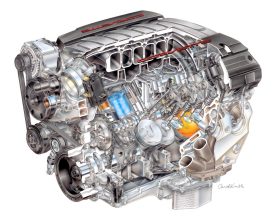
Gen. V LT-1 engine (image courtesy of General Motors).Original-architecture small block engines are still produced as crate engines for Chevrolet Performance and manufactured for marine and industrial applications.
- Original-architecture small block engines are still produced as crate engines for Chevrolet Performance and manufactured for marine and industrial applications.
- The small block wasn’t known as the small block until Chevrolet introduced the big block engine family in 1965–previously, versions were known simply by their cubic-inch designations, i.e. 283, 327, etc., or simply as the Chevy V8.
Bonus fact: We’ll continue commemorating the small block Chevy with more articles as the year unfolds. Stay tuned!
SOURCES: General Motors, Motor Trend, GM Inside News, Summit Racing

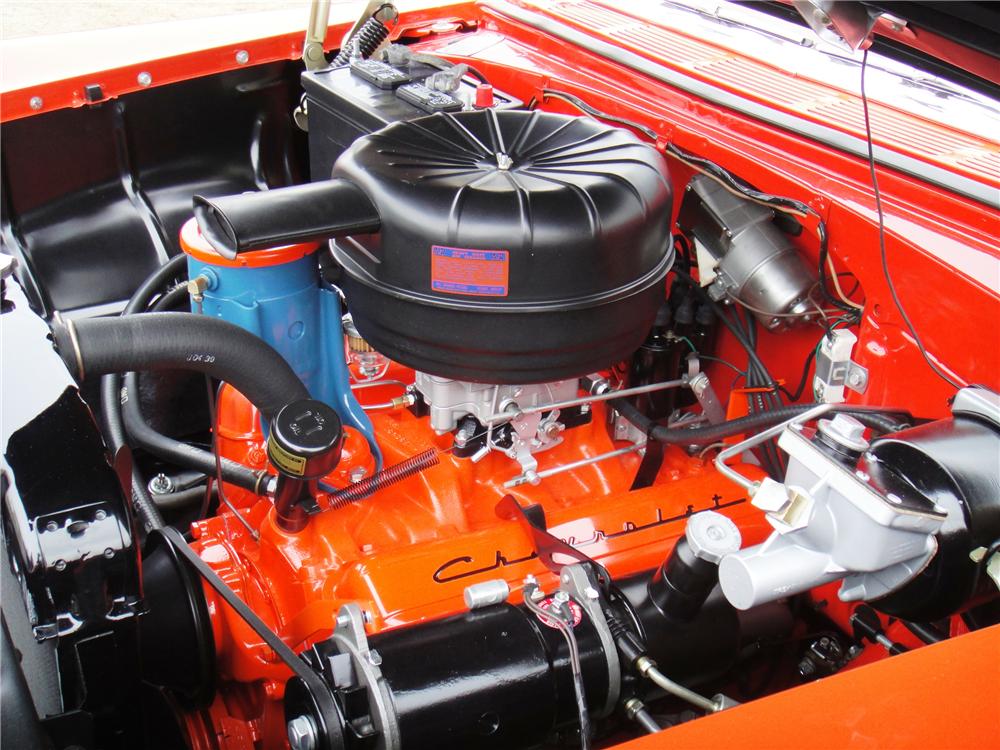
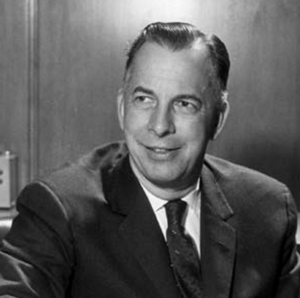
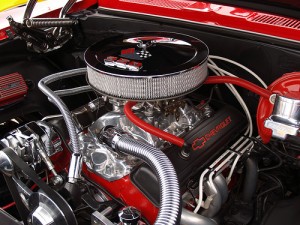
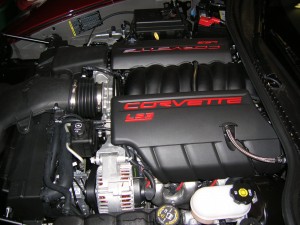
GREAT STORY!!!!! AND INFO. REALY TELL THE TRUTH ABOUT MOTORS MOST PEAPLE DON’T KNOW. THANK YOU SUMMET. AND ON ALL CYLINDERS GREAT STORY!!!
Great article, anything on the inline chevy 6. Remember looking under the hood of a 54 corvette, three gleaming air cleaners on top of what may have been carter carbs horsepower?
You have it right! Three two-barrel side draft Carter carbs on the Blue Flame Corvette. Rather rare these days. Rated conservatively at 150 horsepower in pre-1972 calculation.
[…] we continue to celebrate 60 years of the small block Chevy engine, we thought we’d take a look at some of the small block-based crate engines now available. […]
The 2014 Silverado/Sierra introduced an all new 4.3L based on the Gen V. LS-series, so it’s all aluminum, direct injection and makes 285HP/305TQ. However the older small block Chevy design based 4.3L did run until 2013 unchanged since the early 2000’s (when they switched to multec II injectors in the spider assembly)
I’m one of the guys that went from the Ford Flathead to the Chevy 283’s and of course I added the 2 4s off a Corvette.
[…] will be remembered as the year of the 2015 Mustang and F-150, the 60th anniversary of the Small Block Chevy, the 50th anniversary of the Big Block, and the 30th anniversary of Back to the […]
[…] the small block “Mouse” introduced before it, the “Rat” came in a variety of configurations and horsepower levels. Likewise, it was […]
Great article.am 65 yrs. old.been chevy man since i was 14..easy to get parts .hot rod is in my blood.keep up the good work.Guys like you help me learn new things all the time never BORED.THANKS
Great article. Wasn’t the 348 introduced in 1958 considered a big block (I had one in my 1940 Ford and blasted the just introduced Mustang off the roads in Maryland before being sent overseas).
Yes, Jerry. The 348 was part of the first W-Series big block motors Chevy made. It later got punched out to the much more well-known 409.
…
Those early “Mark I” engines of the late 1950s and early 1960s paved the way for the “Mark IV” big block family, which gave us the familiar 396, 427, 454, and others later in the decade.
[…] Download Image More @ http://www.onallcylinders.com […]
The 305 from 1977 wasn’t reliable initially. They had soft camshafts that wore down to the point where the valves didn’t open, and there was a TSB to cover replacement of the cams. I learned to drive in my Dad’s ’77 Scottsdale C10 with a 305, and I did the paperwork to get reimbursement from GM for the camshaft replacement it had in 1983.
I just have one question. Did Chevrolet sell the blueprint of the 302 to Ford? I read in a Hot Rod magazine years ago, that they sold it to Ford, Ford made changes to the block and introduced it as the Boss 302. Was I hallucinating or did I read that correctly?
No, that is not true at all. Totally different engines with no interchangeable parts.
[…] SBC affords extra energy and prices much less, which is why many decide to place it of their Ford sizzling rods. But there’s a trade-off. Many […]
“The lowest-output small block was the 1975-76 262 V8 rated at 110 horsepower. The supercharged LS9 makes 580 percent more horsepower than it with only 43-percent greater displacement.” Mincing words here…Define displacement: the moving of something from its place or position. What are we moving to generate power, the empty space of cylinders that operate on a vacuum alone or air/fuel/exhaust? Comparing natural aspiration to forced induction is misleading at best; FI is a multiplier of displacement. A more accurate comparison would extrapolate the multiple of standard atmospheric pressure at sea level (14.7psi + 10.5psi boost = 25.2psi) or 1.71 times the displacement of an NA equivalent displacement. In other words a 262 NA small block should be compared to the ls9 as 376 cubic inches (volume) displaced with 171 percent air/fuel at peak horsepower (376 x 1.71 = 643). 643 / 262 = 2.454 so 580 percent more horsepower is made with 245 percent more air and fuel. 43 percent more displacement in a supercharged motor that is forcing 245 percent more air/fuel during the intake stroke increasing the density of vapors during all four cycles. This represents actual gains in technology as forced induction was around long before the Chevy small block was introduced.
Great article) I have swapped LT5 in to my f30 drift project, we managed to het 950hp from the stock engine. Now we need to test 0-60 time.
Nice site
Just curious, which car was the Final Small Block T put in in 2003 ? Malibu?
Hey Justin, are you asking about which cars got the last of the Gen I /II small block Chevy engines? I’m pretty sure the last “cars” that got it were the 5.7L LT1-equipped 1997 Camaro/Firebird, before the LS family took over in 1998. But (again, I think) you could get the SBC in trucks and full-size vans up until 2002.
There are only two generations of small block Chevy engines. The one that came out in 1955 and the one that came out in 1996. Different heads or fuel delivery or cooling does not make it an entirely new engine.
To answer the original question “Did Ford make a 283”. The answer is no!
[…] a small factory, The 267 has found its way under the hood of the Chevy lineupFamous cars such as Camaro, Monte Carlo and El Camino. Exhausting 4.4 liters should give you good […]
I’m confused as the original Chevrolet LS7 in 1970 was a 454 CID big block rated at 465 HP. Why did Chevy resurrect the LS7 designation as a small block?